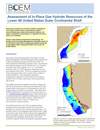Over the course of the past several years, BOEM has made significant advances in our effort to assess the resource potential of gas hydrate in-place on the U.S. Outer Continental Shelf. BOEM enlisted the help of a body of experts from industry, academia, USGS, and other government entities to collaboratively develop a model methodology that would recognize the spatial and temporal variability associated with each OCS region and incorporate the uncertain nature of the inputs deemed critical to the development of a functional gas hydrate petroleum system. The initial product of this effort was a stochastic mass-balance model and the accompanying model input files as developed specifically for the Gulf of Mexico OCS. The Gulf of Mexico assessment results and a complete description of the methodology were published in 2008 under MMS Report 2008-004.
Since that time, the Gulf of Mexico assessment model (both the workflow and the underlying computational code) was modified in ways that made it suitable for an assessment of gas hydrate volumes on both the Atlantic OCS and the Pacific OCS. For each of these latter two OCS areas, input files to the model were developed in a manner similar to that of the approach in the Gulf of Mexico. Assessment results for the in-place volume of gas hydrate on the Gulf of Mexico, Atlantic, and Pacific OCS are now available. Complete model documentation specific to the Atlantic OCS gas hydrate assessment is available through BOEM Report RED 2013-01.
 |
Assessment of In-Place Gas Hydrate Resources of the Lower 48 United States |
Results
The results at this time comprise an analysis of the in-place gas hydrate resources in the Gulf of Mexico, Atlantic, and Pacific OCS areas. The estimates represent only in-place resources, and do not include either technically recoverable or economically recoverable resources.
| Region | In-Place Gas Hydrate Resources | ||
| Gas (Tcfg) | |||
| 95% | Mean | 5% | |
| Atlantic OCS | 2,056 | 21,702 | 52,401 |
| Pacific OCS | 2,209 | 8,192 | 16,846 |
| Gulf of Mexico OCS | 11,112 | 21,444 | 34,423 |
Future Work
BOEM is currently working to adapt the in-place model for use on the deep-water areas of the Alaska OCS. Future assessment results will be updated as they are published. Finally, as more data becomes available a technically recoverable and economically recoverable hydrate volume will be generated for all four regions of the OCS.
